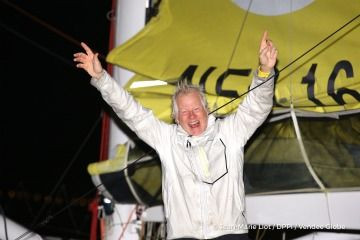DUTCH SAILOR PIETER HEEREMA TAKES SEVENTEENTH PLACE

Dutch skipper Pieter Heerema brought his No Way Back across the finish line of the Vendée Globe at 2126hrs UTC this evening (Thursday 2nd March) to finish in seventeenth place.
Dutch skipper Pieter Heerema brought his No Way Back across the finish line of the Vendée Globe at 2126hrs UTC this evening (Thursday 2nd March) to finish in seventeenth place. Heerema, at 65, completes this epic eighth edition becoming the first skipper from the Netherlands to complete the Vendée Globe. His elapsed time is 116 days 9 hrs, 24 mins and 12 secs. He sailed 29,747 miles at an average speed of 10.65 knots.
During his crossing of the Bay of Biscay aboard his brand new foiler, a boat built in Italy for Andrea Mura, based on designs from VPLP-Verdier and launched in the spring of 2015, Heerema faced a few minor technical problems, in particular with his mainsail hook and a rudder that kicked up several times. The Dutch sailor also suffered from back pains for several days at the start of the race. These problems were resolved but he lost miles to most of the fleet and was in 25th place off the coast of Portugal. The list of repair jobs and technical problems continued to grow. Heerema soon vented his frustration openly criticising equipment manufacturers and the way his boat was fitted out. He also realised his sail choices were not suited to the conditions he was facing. By the time he got to the Doldrums he was in a different weather pattern from what those ahead had experienced and the small losses gradually grew in importance. No Way Back crossed the equator at 2000hrs UTC on 19th November after 13 days and 7 hours.
Conditions were much more pleasant as he went down the coast of Brazil, but he knew he needed to prepare his boat fully for the Southern Ocean. However, Heerema soon got used to the big southern swell and higher speeds. In mid-December in the Indian Ocean, Heerema encountered a lot of problems with his autopilot with the instruments malfunctioning, which meant he experienced some very stressful moments. Once again, this led to a lot of frustration for the Dutch skipper, who was unable to get the advice he was looking for about how to set up his autopilot system.
As Christmas approached, the weather worsened and Heerema admitted he was no longer in race mode preferring to stay inside his boat. He would spend Christmas and Boxing Day working on his autopilot system trying to find the right set-up mode. Before entering the Pacific, his list of repair jobs continued to grow with a lot of wear to deal with on his mainsail. After 60 days at sea, Pieter Heerema passed the halfway mark of the Vendée Globe. « From a competition point of view, during the 60 days of racing, I have rarely been in contact with my competitors and my various technical concerns have forced me to make major detours and slowdowns. Today I am sailing at 60% of No Way Back’s potential. » After 79 days on 24th January, Heerema rounded Cape Horn, a highly emotional moment for the skipper.
The start of the climb back up the Atlantic was far from comfortable. “The banging and smashing worries me. Not for the fillings that may fall out of my teeth. No,no. Not for the teeth that might fall out of my jaws. No, no. Not for the jawbones that may fall out of my head. No, no. I am worried that my head will fall off my torso.” A few days later in warm sunshine in the Forties, his mood lifted and he was able to enjoy some good sailing conditions. But his wind instruments and the data fed to his autopilot still continued to pose problems. He was unable to sleep for long periods as he could not rely on his autopilot and consequently was close to exhaustion at times. Heerema crossed the Equator at 2258hrs UTC on 10th February after 96 days of racing.
In the Doldrums, conditions were very wet and he suffered from a lack of wind. He compared the conditions to being in a tropical rainforest. For his penultimate week conditions were fine, offering good sailing, but Heerema continued to suffer from his electronic and instrument problems. During his final week at sea, the Dutch skipper was forced to slow down to let a nasty storm go by in the Bay of Biscay where 9m high waves were forecast.
Teams info
After a stunning 2025 season Sam Goodchild is the IMOCA Globe Series Champion for the second time
After a long season at the top of the IMOCA fleet that featured three race wins, Great Britain’s Sam Goodchild is for the second time in three years the IMOCA Globe Series Champion.
•••Quel rôle peut jouer la course au large dans la transformation du transport international ? Avec Pie…
Pour ce 10ᵉ épisode de Transitions, enregistré au Havre lors du départ de la Transat Café L'Or, nous recevons Jeremy Pochman, PDG de 11th Hour Racing, et Pierre-Antoine Morvan, responsable du pôle course au large et supe…
•••